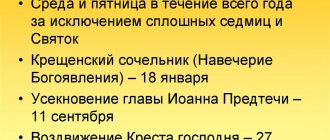Only a few of today's parents were lucky enough to learn the traditions of fasting in childhood. Most grew up in families far from the faith. A parent can easily and organically offer a child and demand from him only what he himself saw in childhood. It is important to understand with all your being, heart, body and soul how our requirements are perceived by the child. Often we do not understand the correctness or disproportionateness of demands that we ourselves did not have to face in childhood.
In such cases, you should be guided by the principle of “do no harm” and seek help and advice from a priest, people with extensive experience in church life, and parents who have raised children.
If there are those in the family who do not fast, you need to be especially careful. Let's assume that only one parent in a family fasts. Either the mother is pregnant, nursing, or the father is unchurched. The task for the child in this case seems more difficult. And parents in this situation will need great wisdom and courtesy. It is important that the fasting parent does not condemn the non-fasting parent either out loud or silently - after all, children are sensitive to the subtext. And a child who thinks that he is doing better than his father or mother by fasting is generally nonsense. Fasting “to spite dad” will do more harm than good on all levels.
Fasting is not a diet
Diet is something for health, something for its own sake. A diet is a set of food restrictions that implies a visible result - the absence of allergies or weight loss.
Fasting does not have a visible result, and this can be a difficult fact for a preschool child. Therefore, when starting and building a fast, you need to explain to the child what it is and why this activity is necessary.
We fast to learn to deny ourselves the usual pleasures. We fast to prepare ourselves for the holiday. Preschool children are purer creatures. And they fast simply as members of their family, out of love for mom and dad and imitation, a natural desire to be like their parents. Because the family is one whole. Fasting at this age is accepted by the child unconditionally, as one of the family traditions. And traditions are not valued or discussed. They simply follow them and live by them.
Young children are big “traditionalists.” They love repetition and familiarity of events. And if the restrictions of fasting are put into a beautiful form that is understandable to a child, it will not be difficult for children.
Schoolchildren learn to be adults. And the skill, work and trials of fasting are a necessary lesson for them. Teenagers and grown children like to make decisions for themselves. Parents can no longer impose their will on them. This is the age when a person learns to take responsibility and see the consequences of his choices. If a child who fasted in childhood now abandons the fast, he will see that he has robbed himself. Exceptions include children who fasted too strictly.
Thinking
The level of thinking that develops in the sixth year of life allows the child to demonstrate the following abilities:
- draw a lesson from a situation, draw a conclusion;
- contrast and compare objects and events;
- group objects, animals and insects according to common characteristics;
- describe what is shown in the picture, build a simple story;
- imagine how a story or film could have ended if the hero had acted differently;
- apply theoretical knowledge in practice.
Reference! At 6 years old, the child’s right and left hemispheres develop at the same pace.
Visibility and tangibility of “Lenten time”
It would be good to make the duration and length of fasting tangible for young children - for example, create a tradition of tearing off a piece of paper on the calendar in the evening, after prayers, and seeing how a thin stack of sheets is made, the last of which is the day of a major holiday, the day the fast ends. You can draw a fasting calendar, and the child will paint another circle every day, realizing that another day of fasting has passed and the holiday is approaching.
In I. Shmelev’s book “The Summer of the Lord,” fasting is wonderfully described through the eyes of a small child.
A special “Lenten” oilcloth or curtains, a TV covered with a scarf, or tucked away “royal dresses” can become signs of fasting for a child. Some non-Lenten objects and events have gone away, others have appeared. They are not better or worse, they are just different.
"No time for service"
spbda/www.flickr.com
This is an incorrect, unchurch epithet, but I would say that the services of Lent are... magical. Before my marriage, I was lucky enough to live for some time at a convent, and for two Great Lents in my life I visited church almost every day, memorizing the Psalter and learning the liturgy of the Presanctified Gifts no worse than the usual liturgy of John Chrysostom. This is an unforgettable, very inspiring experience.
But - “that was a long time ago and not true.” Everything wears out, disappears from memory year after year and day after day. Appearing in church only with children for Sunday liturgy, it is difficult to grasp the special motives of Lent, to hear its amazing strings: mournful and stern, bright and peaceful, strict and decisive... This Lent I really want to attend both the Presanctification and the evening reading of the Great Canon. It’s paradoxical, but last year with three children it was even easier for me to do this than once upon a time with one: at first it still seems that you “can’t do” too much with a child. And then, over time, the understanding comes that with one child you could perhaps fly into space...
Fasting and schoolchildren
Traditionally, some exceptions to the rules of fasting are made for students.
It is important that a student who wishes to fast does not remain hungry all day. This is not good for the body or the psyche. A hungry child is a nervous or overtired child. In this state, it is difficult to assimilate information, and it is easy to provoke conflicts in the family. But in secular educational institutions they do not serve meatless food. Moreover, teachers and after-school teachers from among non-church people can be sure that fasting for a child is harmful and impossible. And they can put pressure on your fasting person, forcing him to eat a sausage or cutlet.
Parents, together with their grown-up child, must figure out how to fast at school carefully, without attracting special attention—pitying or laudatory attention. Teachers should probably be warned and appropriate words come up for classmates.
What should you know before going to school?
It is important that a six-year-old preschooler has the following knowledge:
- knew his full name;
- knew the first and last names of his parents;
- knew how to talk about what his parents do;
- remembered by heart his home address and telephone number;
- navigated the time of day;
- remembered the sequence of seasons;
- remember how many hours are in a day, days in a week, weeks in a month, months in a year;
- knew the names of the days of the week and months of the year;
- knew the primary colors;
- knew the basic spatial concepts: above, below, right, left, between;
- knew how to talk about himself.
Do not advertise the post - do not be shy about the post
Children do not like to be different from others - and therefore, among non-fasting classmates, fasting is doubly difficult. Take this into account and celebrate your child’s efforts. It’s one thing when you don’t see your favorite meat products throughout Lent and aren’t tempted. And it’s completely different when almost everyone around you eats your favorite ice cream.
Tell your child that such a post is worth a lot. A child who learns to fast finds himself in the minority. The world around us lives on as before. Theaters and markets are not closed, as was the case before the revolution in Russia.
He needs to swim against the current. Examples from memoirs of the twentieth century, episodes from the lives of the new martyrs can help. Talk to your child about the difficulties he faces. Don't leave him alone with them. “When you fast, wash your face and anoint your hair with oil...”
It is very important that in front of other non-believing members of the extended family (grandparents) the child does not boast that he is fasting, does not pretend to be a martyr and victim, and does not count on praise and pity. You fast for yourself and for God. This is your personal relationship.
The restrictions of fasting for young children are mainly restrictions on entertainment. Many children need dairy foods. But almost everyone can afford not to eat sweets, not to watch cartoons, and to stop some form of entertainment during Lent. Do not play on the computer, limit your use of the Internet as much as possible. Replacing these activities with others that require concentration and not relaxation - this will be a real effort for the student.
For brothers and sisters, trying to fight and quarrel less is an excellent restriction that can be adopted during Lenten times.
For a child, the work of fasting is to limit oneself to what one loves, which is very pleasant. And if a child does not dare to differ so much from his peers, or his physical health does not allow him to do so, then he can simply refuse a tasty dish prepared in a certain way.
If a child persistently asks for a certain product, this is hardly a whim. The food cravings of young children are similar to those of pregnant women.
Personal opinion: in my opinion, if a preschool child systematically asks for any product during Lent (from the main list of protein or dairy products), it is better to give him the opportunity to eat it. You can time such a “break of fasting” to coincide with Sunday by asking the priest’s opinion about various kinds of deviations before the start of fasting. Children grow very actively - and sometimes the desire to eat cottage cheese or yolk is not caused by a whim or a delicacy - but by an urgent need of the body. But only the desired product should be prepared without frills, as simply as possible, and maybe even without salt - so that it is less tasty. The child himself, understanding how adults and brothers and sisters refuse favorite, tasty things, will learn to limit himself. Gradually a culture of fasting will emerge. And its extent will grow with the child.
"Mom can"
Laura Gilchrist
A nursing mother, a pregnant mother, a tired mother, a sick mother... Sometimes a small catastrophe begins with a useful and well-founded relaxation in fasting. It would seem that fasting is not about food and drink, or rather, not only about them, but excessive abstinence is sometimes harmful to health and thus interferes with the fulfillment of maternal duties. But another thing is also true: when relaxation becomes relaxation, Lent unexpectedly quickly and without a trace flies past you, not leaving you even with the feeling of an “eleventh-hour worker” by Easter.
With all the necessary indulgences, at least minimal physical signs of fasting are necessary. This may be empty cottage cheese instead of cottage cheese dessert, refusal of sweets and other harmless restrictions, but they will be everyday, routine, constantly reminding us here, in everyday life, of our involvement in the vastness of church tradition. Actually, this is the minimum fasting that can be offered to children without any harm to the growing body.
Older children and toddlers who are not yet fasting
For older children, who are already subject to the strictures of fasting, it is not easy to watch how kids and their younger brothers and sisters eat something prohibited for them. It’s better to move these moments to the first half of the day, when the older ones are at school.
In the eyes of elders, the post should become the privilege of adults. A process, a thing that you need to grow into. “You fast like an adult, but you, like an adult, can go on a trip with your dad or go on a visit with your mom without the kids.” Permission to fast should be a step closer to parents.
Fasting can be presented as a privilege, as something “only for adults” that kids still have to grow into. In modern parlance, “raise the rating of a post.” Fasting should be an honor. A growing child understands that by sharing a fast with his parents, he deserves their respect. The common work of fasting should bring parents and older children together, not divide them.
Features of six-year-old babies
Six years is the senior preschool age.
Of course, by this time the child’s personality, his psychotype and predisposition to a certain type of occupation are already visible.
However, when analyzing the level of development, it is worth focusing on the average level of skills. The child should be able to:
- find differences between two objects;
- continuously engage in something (exercise, game) for longer than 15 minutes;
- imitate - this list includes facial expressions, gestures and even copying drawings;
- remember up to 10 items (for example, what is in the desk drawer);
- conduct a dialogue - meaningfully answer and ask questions;
- memorize short passages of prose and poetry no longer than four sentences;
- recognize a song or story from a passage;
- find an “extra item” from the proposed list and justify your choice;
- put together a mosaic, a construction set, or sculpt a figurine according to a model;
- draw - animal objects, etc. are clearly recognizable in the child’s drawings;
- fill the drawing with color - coloring, shading;
- write letters and numbers or at least some of them;
- ride a tricycle or scooter;
- independently perform hygiene procedures, dress, put on shoes, undress, etc.;
- be able to cut carefully with scissors;
- to navigate in space - to understand where is left, where is right, where is up and where is down.
This list of skills is common to both boys and girls.
Delicious traditions and Sunday joys: the culture of fasting
Lenten food may not be very tasty. It is our spoiled taste of city dwellers that is accustomed to all sorts of delights. And children, especially preschoolers, love food that is simple in composition and preparation. Lent has its own delicacies, and each of the four fasts has its own “signature dish.”
It’s good if a family has a tradition of cooking something special, lean, but tasty on Sundays. Something that is served to the table during Lent: candied nuts, special dried fruits or marmalade, a special Lenten gingerbread or baked apples. It will be extraordinary, it will be memorable.
Speech
By the age of 6, a child should be able to:
- pronounce and use in your vocabulary words consisting of three or more syllables;
- operate with complex sentences;
- use simple and complex prepositions in speech;
- form comparative degrees from adjectives;
- use antonyms, synonyms, generic concepts in the active vocabulary;
- retell heard fairy tales;
- make up your own stories;
- understand and use logical-grammatical structures.
Ask everyone according to their own measure
All children experience hunger or restrictions on sweets differently. There are also those who cannot tolerate it at all. Many children, due to health problems or increased stress, cannot fast.
We must remember that fasting is, first of all, an effort, a training of the will. Fasting is voluntary. But the child’s will has not yet matured. It, as psychologists say, is in the formative stage. Parents can help this process. But if adults do not feel and do not understand the individual and age-related characteristics of the child and impose unbearable restrictions on him, a pronounced “rollback” from faith in adolescence is possible. In a post, you need to evaluate the effort, not the result. Children's successes should be celebrated with praise, and failures should be smoothed out.
Fine motor skills
At 6 years old, a preschooler should easily cope with the following tasks:
- draw with a pencil, felt-tip pen, chalk;
- move your palms in accordance with the rhythm of the educational rhyme “okay-okay”, “magpie-crow” or count by bending your fingers;
- play with a puzzle or construction set;
- sculpt from plasticine or kinetic sand;
- draw with your finger on the grain or sand, separate one type of grain from another, or, as an alternative, sort out the buttons by size;
- lace, tie and untie shoes independently;
- play with finger puppets.
Post from a psychologist's point of view
Home test - are children waiting for the next Lent with horror or “Lenten” faces, or are they rejoicing: now, Lent is coming again, and we will bake Lenten pies, and then Christmas will soon be there? Do they think: Mom (Dad) is especially strict and angry during Lent. Or we are especially attentive, and we watch filmstrips, which we usually don’t get around to doing.
It is extremely important that there is no breakdown of will on the one hand and there is no desire to dissemble, deceive, or secretly feast on the other.
But if the culture of fasting is not instilled in the family from childhood, it is very difficult for an adult to assimilate it. Girls will not learn lenten cooking from childhood, and boys will never be able to imagine life without butter and meat.
Nowadays, fasting is not so easy - after all, it contradicts the slogan “take everything from life.” You must learn to fast peacefully, taking into account your own and others’ mistakes. And we, parents, often learn to fast with our children.
Social sphere
A preschooler, even if he does not go to kindergarten, recognizes himself as part of society and has simple communication skills:
- says hello and goodbye;
- thanks for services and gifts;
- strive to be understood both by adults and by peers;
- shows sympathy and antipathy towards people;
- actively involved in collective activities;
- Shows dedication and patience when implementing the assigned task.
Educational cartoons
Educational cartoons for preschoolers should convey simple truths in an easy, unobtrusive and entertaining form. These could be the physical properties of objects, stories about distant countries, concepts of good and evil, or norms of behavior according to gender.
Among Russian cartoons, the following are particularly noteworthy:
- Fixies;
- Smeshariki;
- Pin;
- Mountain of Gems;
Six years is the age at which your child says goodbye to carefree everyday life in kindergarten and takes the first step towards adulthood - enters school. Make sure that your baby does not experience difficulties with adaptation and prepare him in advance for the new stage. Educational games, activities and toys will help you with this.
The intellectual side
Thanks to the thirst for knowledge and craving for everything new, a 6-year-old child is distinguished by the following intellectual abilities:
- forms and asks questions;
- remembers and uses the information received in dialogue;
- performs simple sound analysis of words;
- knows how to carry on a conversation with a peer or adult;
- capable of a long monologue;
- knows how to briefly retell what he saw or read, separating the primary from the secondary;
- is able to collectively fantasize with peers, improving and supplementing the rules of the old game.










